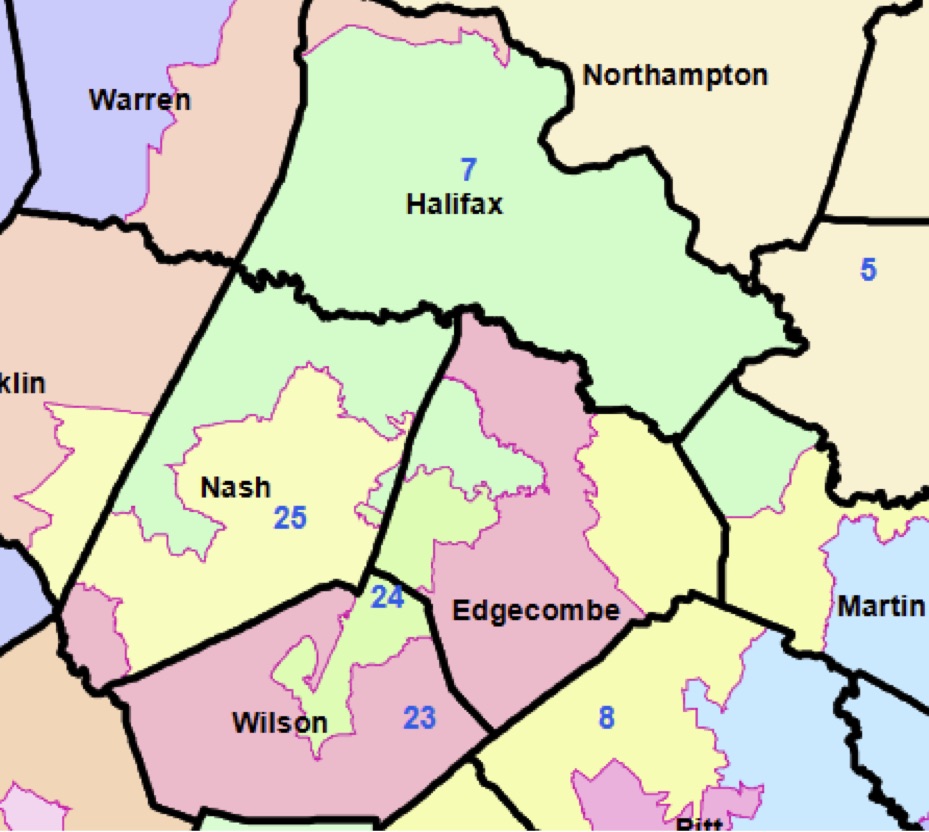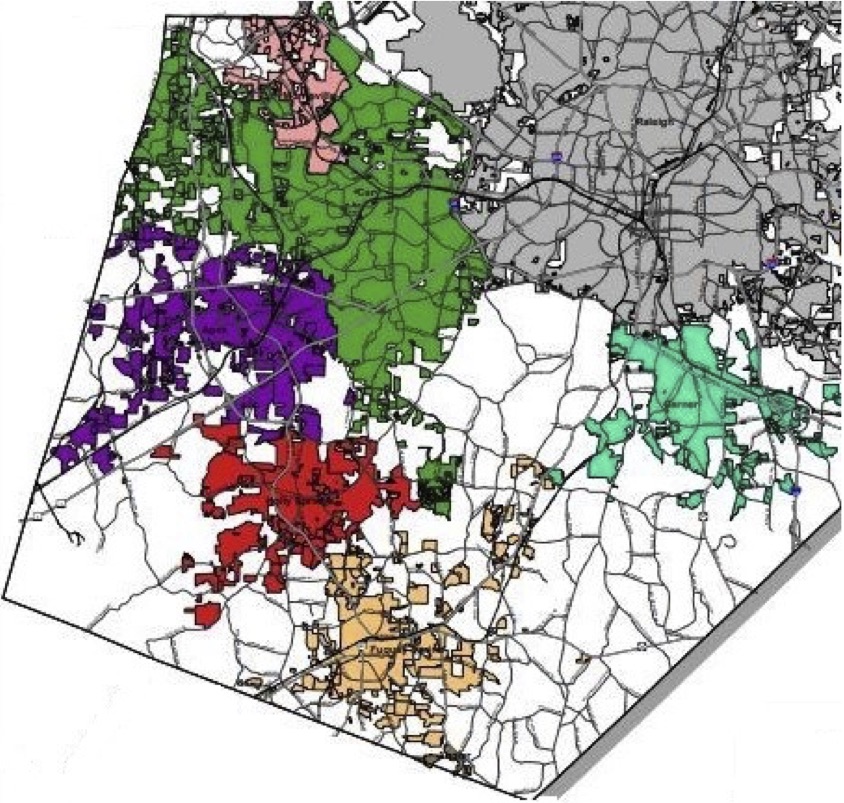- North Carolina’s constitution and related court cases severely limit how counties can be divided when forming state legislative districts
- Precincts sometimes must be split when forming districts but doing so is disruptive for election officials and voters and should be avoided
- It is often not practical to follow municipal boundaries when drawing district maps
The North Carolina General Assembly House Committee on Redistricting and Senate Committee on Redistricting and Elections adopted redistricting criteria in a joint meeting on August 12. Those criteria control how legislators will draw congressional and General Assembly (House and Senate) districts. While much of those criteria are self-explanatory, they include some nuance and backstory that are worth exploring to understand better how and why they are used to constrain legislators as they draw districts.
This part of a three-part series examines criteria related to political boundaries (counties, municipalities, and precincts). Part 2 looks at criteria related to geography other than political boundaries (contiguity, compactness, and equal population). Part 3 reviews what map drawers may not consider (election data, racial data) and nonmandatory considerations (member residence, communities of interest).
Counties
Each section will begin with language taken directly from the criteria adopted by the joint redistricting committees. Here are the criteria concerning political boundaries:
- Counties, Groupings, and Traversals. The Committees shall draw legislative districts within county groupings as required by Stephenson v. Bartlett, 355 N.C. 354, 562 S.E.2d 377 (2002) (Stephenson I), Stephenson v. Bartlett, 357 N.C. 301, 582 S.E.2d 247 (2003) (Stephenson II), Dickson v. Rucho, 367 N.C. 542, 766 S.E.2d 238 (2014) (Dickson I) and Dickson v. Rucho, 368 N.C. 481, 781 S.E. 2d 460 (2015) (Dickson II). Within county groupings, county lines shall not be traversed except as authorized by Stephenson I, Stephenson II, Dickson I, and Dickson II.Division of counties in the 2021 Congressional plan shall only be made for reasons of equalizing population and consideration of double bunking. If a county is of sufficient population size to contain an entire congressional district within the county’s boundaries, the committees shall construct a district entirely within that county.
The North Carolina State Constitution requires that counties not be divided when creating districts. It also requires that districts be roughly equal in population. Those criteria were once balanced by creating multimember districts in more populous counties. That system was ruled unconstitutional in Stephenson v. Bartlett (2002; i.e., Stephenson I).
In its place, the court imposed a system of county clusters (groupings) and refined that system in subsequent rulings over the next decade (referred to as Stephenson II, Dickson I, and Dickson II). The first step in drawing N.C. House and Senate maps is grouping counties into clusters that contained the minimum number of districts within the minimum number of counties. A full description of the county grouping process is beyond the scope of this research brief, but I highly recommend Blake Esselstyn’s “‘Stephenson’ explainer” to learn more.
The court also limited how district lines can cross (traverse) county lines for state legislative districts. Figure 1, a detail from the Sutton House Plan 3 that passed the General Assembly in 2001, illustrates two court-banned practices. First, Edgecombe and Wilson counties were divided both by districts 23 and 24. Under Stephenson, one of those counties must be wholly within one district, and the other county would be divided between them. Second, district 7 occupied two noncontiguous parts of Nash County. Under Stephenson, all of a district within a county must be contiguous. Those rules minimalized county splitting and severely constrained how creative legislators can be when drawing districts.

Figure 1: Detail of Sutton House Plan 3, passed by the General Assembly in 2001. Source: North Carolina General Assembly.
While there is no constitutional limit on splitting counties for congressional districts, the adopted criteria require the General Assembly to minimalize county splits when drawing those districts. Two counties, Mecklenburg and Wake, are large enough to contain entire districts. To comply with the standards passed by the redistricting committees, those two counties will wholly contain one congressional district with the rest of the counties wholly contained within one other district unless there is a need to divide a county three ways to equalize district populations or prevent putting two representatives in the same district. That latter concern only applies to Mecklenburg County, which hosts two representatives: Alma Adams and Dan Bishop.
Voting Tabulation Districts (precincts)
Here is more language taken directly from the criteria adopted by the joint redistricting committees:
-
VTDs. Voting districts (“VTDs”) should be split only when necessary.
Voting tabulation districts (VTDs, precincts) are most often split to conform to congressional districts’ equal population requirements. They are also split to help state legislative districts state within ± 5% of their ideal population. Splitting VTD’s creates a logistical headache for election workers since they must distribute multiple types of ballots within those VTDs. It also increases the chance that voters will be assigned the wrong ballot. So it is good that legislators are seeking to minimalize the number of split VTDs.
Municipalities
They also passed criteria regarding municipal boundaries:
-
Municipal Boundaries. The Committees may consider municipal boundaries when drawing districts in the 2021 Congressional, House, and Senate plans.
It is often not possible for map drawers to respect county and municipal boundaries equally. That is especially true when municipal and county boundaries cross, such as Rocky Mount (in Nash and Edgecombe counties) and High Point (divided between four counties).
Even when county and municipal boundaries do not cross, the joint committee favors respecting county boundaries (“shall draw”) over municipal boundaries (“may consider”). There are two reasons for that. The first, at least for state legislative districts, is legal. The North Carolina State Constitution (Article II, Sections 3 and 5) requires that counties not be divided when drawing districts. While complying with that requirement is not always possible due to the requirement that all districts be equal in population, it must be respected whenever possible. There is no such constitutional requirement for municipal boundaries.
Second, attempting to respect municipal boundaries when drawing districts is often impractical.
North Carolina’s permissive annexation laws allow municipalities to grow in ways that make them appear more convoluted than the worst gerrymanders. Municipalities can even grab noncontiguous territory. Figure 2 shows the convoluted boundaries of several municipalities in southern Wake County. Municipalities across the state have similar territorial peninsulas, isthmuses, and islands.

Figure 2: Map of southern Wake County indicating the boundaries of several municipalities. Source: Wake County government.
While it is usually possible to include most of a municipality within a single district, it is not possible to respect municipal boundaries without often splitting VTDs. Trying to do so would also violate the redistricting criteria of compactness and contiguity (which will be presented in part 2 of this series).


